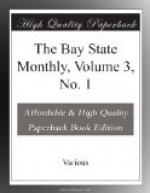more than home and dearer than life. Nor was
this “vast extent of wilderness” to which
they succeeded by right of purchase from the heirs
of Chickatabat any such narrow area as that of the
same name, recently annexed to the city of Boston.
It extended from what is now the northern limit of
South Boston to within a hundred and sixty rods of
the Rhode Island line, thus giving the township a
length of about thirty-five miles “as y’e
road goethe.” The late Ellis Ames, of Canton,
a competent authority, says the town “was formerly
bounded by Boston, Roxbury, Dedham, Wrentham, Taunton,
Bridgewater and Braintree,” so that its history
is the history of a large part of the towns in Norfolk
county and a portion of Bristol. The manner in
which the original territory has been gradually reduced
is thus told by Mr. Ames: “Milton was set
off in 1662; part of Wrentham, in 1724: Stoughton,
in 1726; Sharon, in 1765; Foxborough, in 1778; Canton,
in 1797; strips were also set off to Dedham, probably,
in 1739; and before the whole was annexed, portions
of the northern part of the town were set off to Boston,
at two several times: in 1804 and in 1855.”
Since that date another portion has been severed to
make the northern quarter of Hyde Park. Honorable
John Daggett, the historian of Attleborough, which
was then a part of the Rehoboth North Purchase, says
there was a dispute concerning the boundary between
Dorchester and that town, which was finally settled
by a conference of delegates, held at the house of
one of his ancestors.
Why those “most Godly and Religious People”
chose to settle where they did rather than on the
Charles river, as at first intended, Mr. Blake proceeds
to tell us in his annals. He says they made the
voyage from England to New England in a vessel of
four hundred tons, commanded by Captain Squeb, and
that they had “preaching or expounding of the
Scriptures every day of their passage, performed by
Ministers.” Contrary to their desires,
the ship discharged them and their goods at Nantasket,
but they procured a boat in which part of the company
rowed into Boston harbor and up the Charles river,
“until it became narrow and shallow,”
when they went ashore at a point in the present village
of Watertown. But after exploring the open lands
about Boston, they finally made choice of a neck of
land “joyning to a place called by y’e
Indians Mattapan,” because it formed a natural
inclosure for the cattle they had brought with them,
and which, if turned into the open land, would be
liable to stray and be lost. This little circumstance
fixed the original settlement on the marsh now known
as Dorchester Neck.




